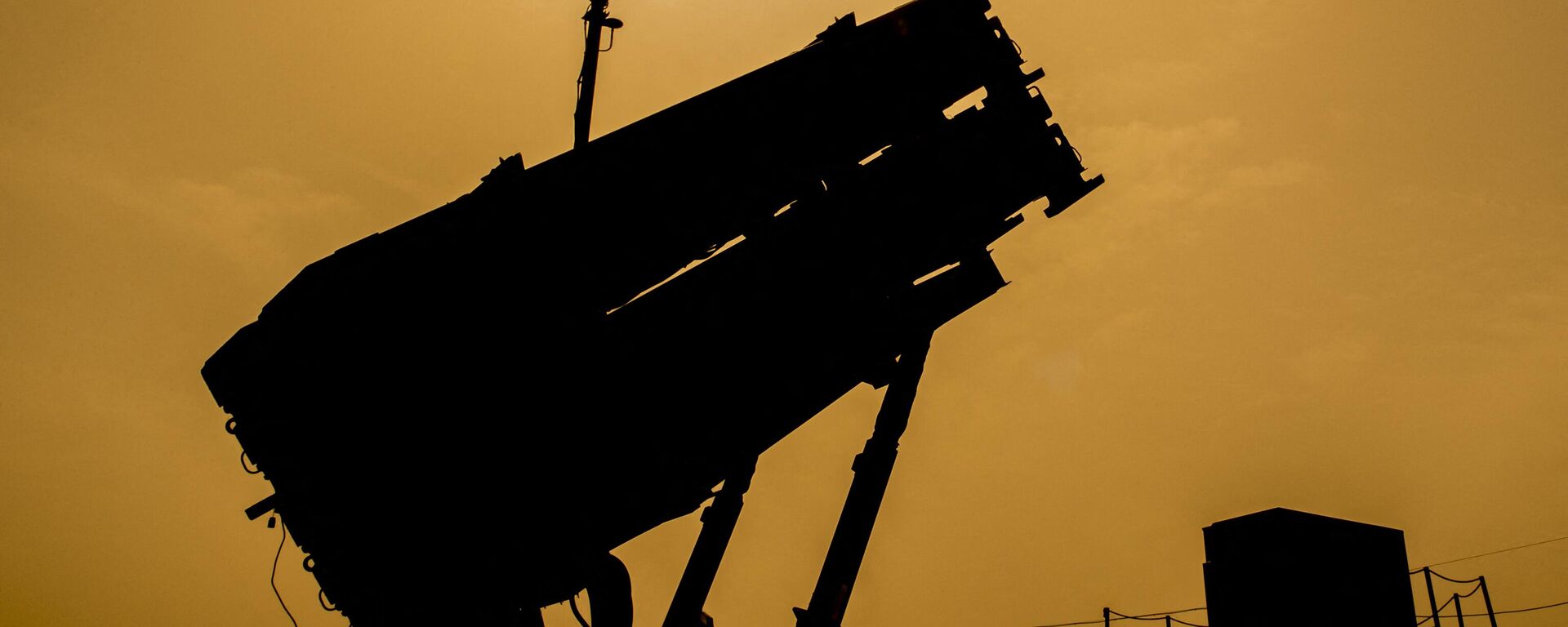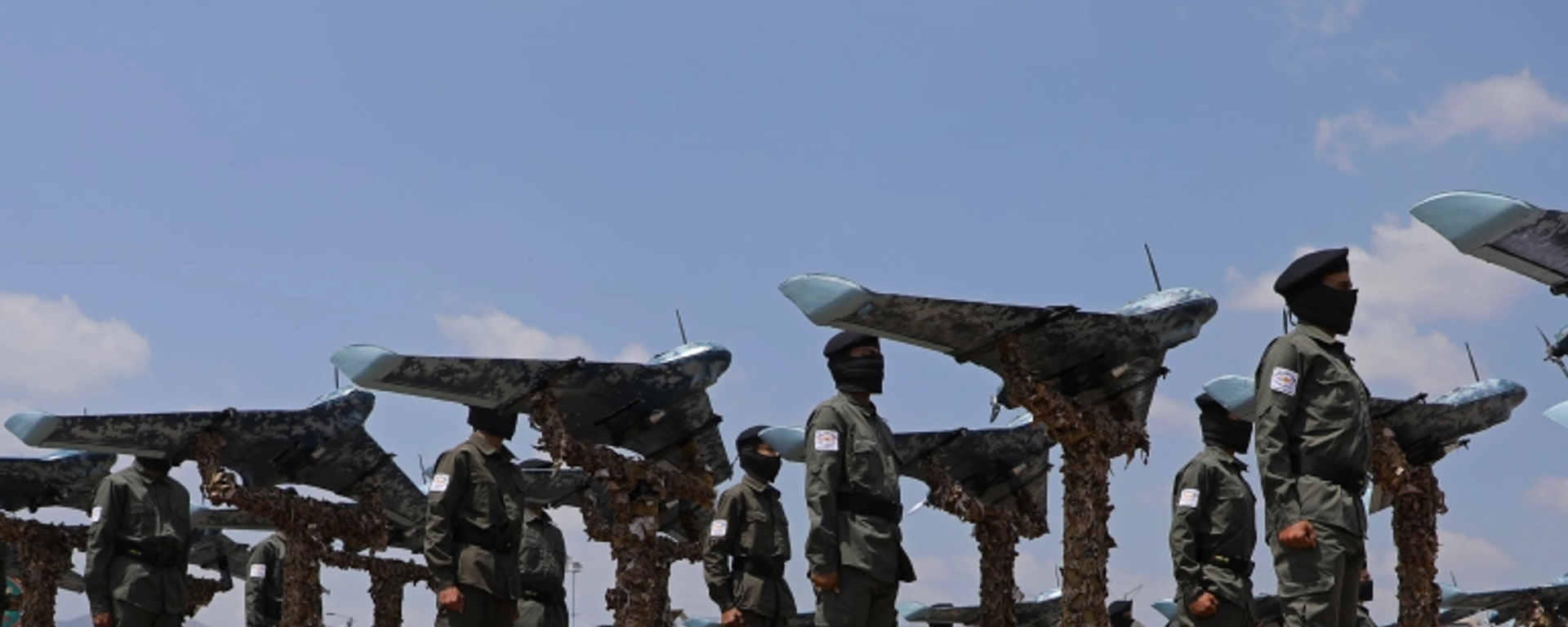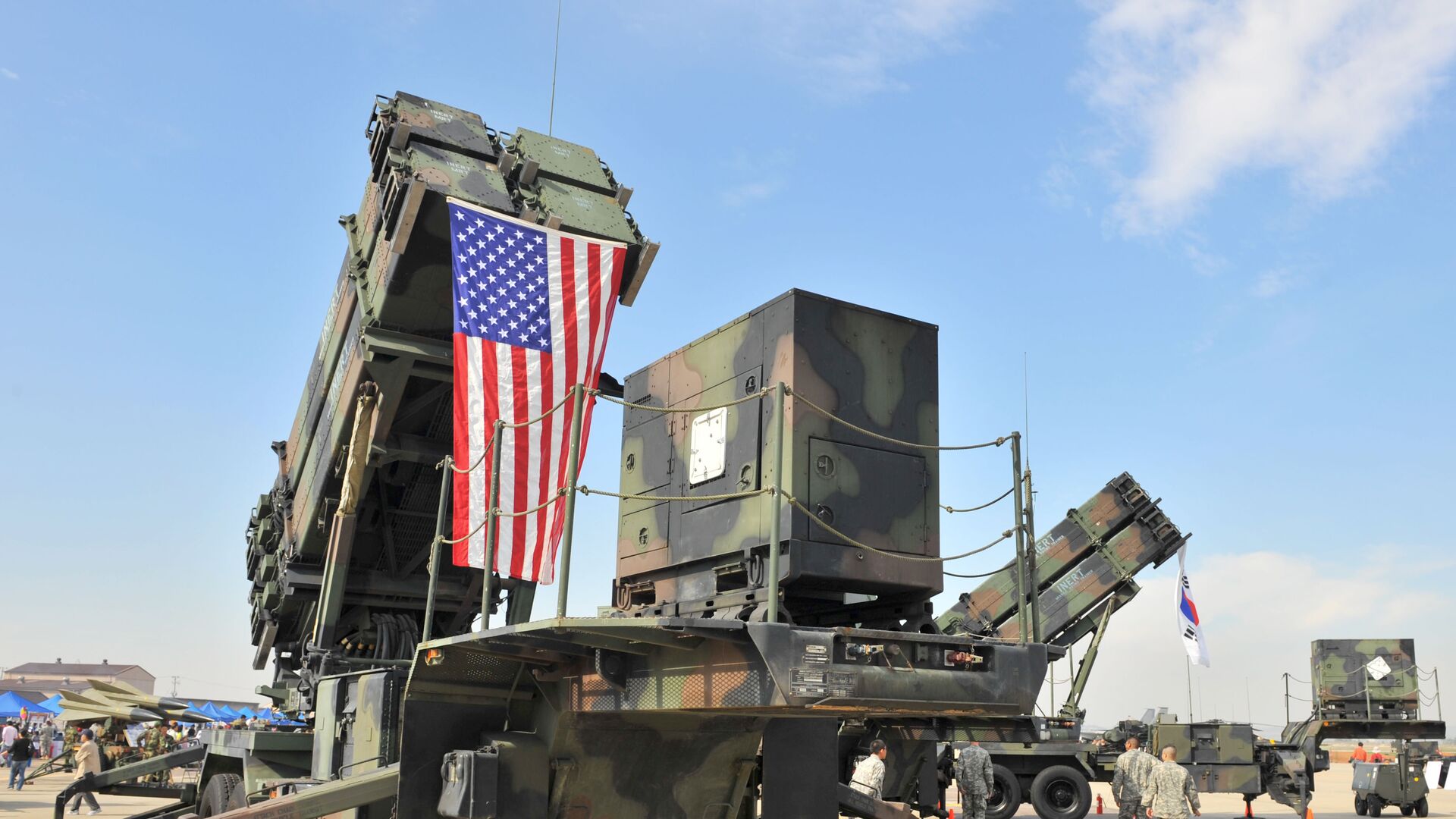https://sputnikglobe.com/20221214/pointless-patriots-why-sending-the-us-missile-system-to-ukraine-wouldnt-do-kiev-any-good-1105463293.html
Pointless Patriots: Why Sending the US Missile System to Ukraine Wouldn’t Do Kiev Any Good
Pointless Patriots: Why Sending the US Missile System to Ukraine Wouldn’t Do Kiev Any Good
Sputnik International
Various US media have reported that the Pentagon is “finalizing plans” to send MIM-104 Patriot surface-to-air missile systems to Ukraine. Apart from the... 14.12.2022, Sputnik International
2022-12-14T17:52+0000
2022-12-14T17:52+0000
2022-12-14T18:28+0000
military
patriot
mim-104 patriot
patriot missile system
patriot 3 (pac-3) air defence missile
ukraine
us
https://cdn1.img.sputnikglobe.com/img/103449/99/1034499900_0:0:3720:2094_1920x0_80_0_0_e8fa54b07e1b15e4f5fe134ce798dc42.jpg
The White House could not confirm Wednesday that the US was planning to send Patriot missile systems to Ukraine. "When it's ready to announce and speak to the details, we'll certainly do that," US National Security Council spokesman John Kirby said, speaking to reporters in Washington.Media reports on US plans to send Patriots to Ukraine have not specified which variant of the missile system Washington plans to potentially send. Jane’s speculates it would involve the deployment of a single truck-mounted Patriot battery with four launchers, capable of carrying up to eight PAC-3 interceptors.The US Army touts the Patriot as its "premier" guided air and missile defense system. The weapon, which went into service in the 1980s, and has been sold to over a dozen US allies in the decades since, is designed to engage a wide array of aerial targets, from drones, ballistic and cruise missiles to jets and helicopters. Its missiles’ operational range varies from 90 km for the PAC-1, to 160 km for the PAC-2, to between 30 and 60 km for the PAC-3/PAC-3MSE. The missiles have a maximum altitude of over 24 km, and operate at speeds between Mach 2.8-Mach 4 – enough to intercept almost any incoming projectile (in theory anyway).But the delivery of such a weapons system to Ukraine, especially if it’s just a single battery, might be of questionable value to Kiev. Here's why.Questionable Performance Against IraqDespite its widespread deployment (the US Army alone has over 1,100 launchers in its inventory) and its cost ($1-6 million per missile, and a cool $1 billion for a PAC-2 battery consisting of eight launchers) the Patriot’s operational history hasn’t exactly proven it to be a stellar buy.During the Gulf War in February 1991, a Patriot missile failed to track and intercept an Iraqi Scud missile targeting an American base in Saudi Arabia, with the Scud hitting a barracks and killing 28 Pennsylvania National Guard servicemen and injuring 100 others. Raytheon and the Pentagon dismissed the failure as a software malfunction, and classified the system as a “miracle” weapon that had proven its effectiveness.However, an October 1992 report to the House of Representatives’ Government Appropriations Committee revealed that “using the Army’s own methodology,” Patriots were shown to have “hit only 9 percent of the Scud warheads engaged,” with the Scuds’ speed, “limitations of the Patriot missile system, and the confusion and targeting difficulties caused by the break-up of the Scud missile as it re-entered the atmosphere” contributing “to the high failure rate.”Questionable Performance in Saudi ArabiaSaudi Arabia is a major Patriot operator, fielding dozens of systems and hundreds of PAC-3 missiles and constantly requesting more. However, despite this vast arsenal (complemented by the Raytheon Improved Hawk and Lockheed Martin THAAD ABM systems in the kingdom’s inventory), Riyadh has faced repeated missile and drone attacks from neighboring Yemen by Houthi militants, with Saudi Arabia's mostly US-bought air defense equipment seemingly powerless to stop the militants.In 2019, the Houthis temporarily knocked out about half of Saudi Arabia’s oil production in a massed drone and missile strike deep into its oil-producing heartland, with its Patriot defenses nowhere to be found. A year earlier, a Houthi attack on Riyadh killed one person and injured two others, with a Patriot system deployed to guard against attack failing to intercept the incoming projectiles despite launching at least five interceptors. In March of this year, Saudi Aramco’s massive Jeddah oil depot was hit by another militia attack, with Patriots again MIA.“It’s nothing but an unbroken trail of disasters with this weapon system,” Theodore Postol, an MIT physicist known for his criticism of the Patriot, said following the 2018 Riyadh attack.Failure in Japan?In August and September 2017, North Korea test fired two long-range ballistic missiles, flying them over Japan’s northern island of Hokkaido before touching them down in the Pacific. After the tests, then-US President Donald Trump privately asked then-Japanese Prime Minister Shinzo Abe why Tokyo, whose sophisticated air defenses include six battalions of Patriots and seven warships equipped with Aegis ballistic missile defenses, failed to destroy the projectiles. Trump reportedly could not “understand why a country of samurai warriors did not shoot down the missiles.”US media have offered a pretty simple explanation as to why Japan did not use its American-made weapons against the North Korean missiles: they were flying outside air and missile defense forces’ intercept range.Test Target?The Patriot missile system is a complex piece of equipment. In addition to its launchers, components include an AN/MPQ-65 phased array radar set to scan for targets, an "Engagement Control/Operations Center," optional 31-meter high antenna masts, and optional Mobile EPP-III Electric Power Plant, pumping out power from two 150-kW diesel engines.The Patriot is road mobile, and can be deployed and prepared to fire in about 30 minutes.However, unlike standalone, mobile short-range air defense systems or artillery, which can fire their complement of missiles or rockets in 1-3 minutes and evacuate (a tactic called "shoot and scoot"), Patriots are not that nimble. Furthermore, given their bunching in groups of vehicles, the systems can be easily picked up by enemy satellites, making them a sitting target for adversaries armed with missiles that can evade ordinary missile defenses, or even those with enough ordinary missiles or drones to overwhelm the system.Consequently, if the US goes ahead with the delivery of Patriots to Ukraine, it may quickly turn into an opportunity for Russia to test the effectiveness of its Kinzhal hypersonic missile against the missile defense system. In fact, that may very well be the true purpose of the Pentagon deploying the system in Ukraine to begin with.
https://sputnikglobe.com/20221214/us-may-reportedly-announce-plans-to-deliver-patriot-missile-defense-system-to-ukraine-within-days--1105436798.html
https://sputnikglobe.com/20221003/yemens-houthis-warn-foreign-oil-companies-to-get-out-of-saudi-arabia-uae-as-ceasefire-crumbles-1101473725.html
https://sputnikglobe.com/20221006/south-korea-and-japan-condemn-north-korean-missile-launches-1101556132.html
ukraine
Sputnik International
feedback@sputniknews.com
+74956456601
MIA „Rossiya Segodnya“
2022
News
en_EN
Sputnik International
feedback@sputniknews.com
+74956456601
MIA „Rossiya Segodnya“
Sputnik International
feedback@sputniknews.com
+74956456601
MIA „Rossiya Segodnya“
patriot missile system, patriot missile, patriot, us, ukraine, deployment, air defense, missile defense, air and missile defense
patriot missile system, patriot missile, patriot, us, ukraine, deployment, air defense, missile defense, air and missile defense
Pointless Patriots: Why Sending the US Missile System to Ukraine Wouldn’t Do Kiev Any Good
17:52 GMT 14.12.2022 (Updated: 18:28 GMT 14.12.2022) Various US media have reported that the Pentagon is “finalizing plans” to send MIM-104 Patriot surface-to-air missile systems to Ukraine. Apart from the obvious logistical and training issues, there are a number of other unanswered questions surrounding the system’s potential deployment. Sputnik explores some of them.
The White House could not confirm Wednesday that the US was planning to send Patriot missile systems to Ukraine. "When it's ready to announce and speak to the details, we'll certainly do that," US National Security Council spokesman John Kirby said, speaking to reporters in Washington.
Media reports on US plans to send Patriots to Ukraine have not specified which variant of the missile system Washington plans to potentially send. Jane’s
speculates it would involve the deployment of a single truck-mounted Patriot battery with four launchers, capable of carrying up to eight PAC-3 interceptors.
The US Army touts the Patriot as its
"premier" guided air and missile defense system. The weapon, which went into service in the 1980s, and has been sold to over a dozen US allies in the decades since, is designed to engage a wide array of aerial targets, from drones, ballistic and cruise missiles to jets and helicopters. Its missiles’ operational range varies from 90 km for the PAC-1, to 160 km for the PAC-2, to between 30 and 60 km for the PAC-3/PAC-3MSE. The missiles have a maximum altitude of over 24 km, and operate at speeds between Mach 2.8-Mach 4 – enough to intercept almost any incoming projectile (in theory anyway).

14 December 2022, 06:21 GMT
But the delivery of such a weapons system to Ukraine, especially if it’s just a single battery, might be of questionable value to Kiev. Here's why.
Questionable Performance Against Iraq
Despite its widespread deployment (the US Army alone has over 1,100 launchers in its inventory) and its cost ($1-6 million per missile, and a
cool $1 billion for a PAC-2 battery consisting of eight launchers) the Patriot’s operational history hasn’t exactly proven it to be a stellar buy.
During the Gulf War in February 1991, a Patriot missile failed to track and intercept an Iraqi Scud missile targeting an American base in Saudi Arabia, with the Scud hitting a barracks and killing 28 Pennsylvania National Guard servicemen and injuring 100 others. Raytheon and the Pentagon dismissed the failure as a software malfunction, and classified the system as a “miracle” weapon that had proven its effectiveness.
However, an October 1992
report to the House of Representatives’ Government Appropriations Committee revealed that “using the Army’s own methodology,” Patriots were shown to have “hit only 9 percent of the Scud warheads engaged,” with the Scuds’ speed, “limitations of the Patriot missile system, and the confusion and targeting difficulties caused by the break-up of the Scud missile as it re-entered the atmosphere” contributing “to the high failure rate.”
Questionable Performance in Saudi Arabia
Saudi Arabia is a major Patriot operator, fielding
dozens of systems and hundreds of PAC-3 missiles and
constantly requesting more. However, despite this vast arsenal (complemented by the Raytheon Improved Hawk and Lockheed Martin THAAD ABM systems in the kingdom’s inventory), Riyadh has faced repeated missile and drone attacks from neighboring Yemen by Houthi militants, with Saudi Arabia's mostly US-bought air defense equipment
seemingly powerless to stop the militants.
In 2019, the Houthis temporarily knocked out about half of Saudi Arabia’s oil production in a massed drone and missile strike deep into its oil-producing heartland, with its Patriot defenses nowhere to be found. A year earlier, a Houthi attack on Riyadh killed one person and injured two others, with a Patriot system deployed to guard against attack failing to intercept the incoming projectiles
despite launching at least five interceptors. In March of this year, Saudi Aramco’s massive Jeddah oil depot was hit by another militia attack, with Patriots again MIA.
“It’s nothing but an unbroken trail of disasters with this weapon system,” Theodore Postol, an MIT physicist known for his criticism of the Patriot,
said following the 2018 Riyadh attack.

3 October 2022, 16:26 GMT
In August and September 2017, North Korea test fired two long-range ballistic missiles, flying them over Japan’s northern island of Hokkaido before touching them down in the Pacific. After the tests, then-US President Donald Trump privately asked then-Japanese Prime Minister Shinzo Abe why Tokyo, whose sophisticated air defenses
include six battalions of Patriots and seven warships equipped with Aegis ballistic missile defenses, failed to destroy the projectiles. Trump reportedly could not
“understand why a country of samurai warriors did not shoot down the missiles.”US media have offered a pretty
simple explanation as to why Japan did not use its American-made weapons against the North Korean missiles: they were flying outside air and missile defense forces’ intercept range.

6 October 2022, 03:47 GMT
The Patriot missile system is a complex piece of equipment. In addition to its launchers, components
include an AN/MPQ-65 phased array radar set to scan for targets, an "Engagement Control/Operations Center," optional 31-meter high antenna masts, and optional Mobile EPP-III Electric Power Plant, pumping out power from two 150-kW diesel engines.
The Patriot is road mobile, and can be deployed and prepared to fire in
about 30 minutes.
However, unlike standalone, mobile short-range air defense systems or artillery, which can fire their complement of missiles or rockets in 1-3 minutes and evacuate (a tactic called
"shoot and scoot"), Patriots are not that nimble. Furthermore, given their bunching in groups of vehicles, the systems can be easily picked up by enemy satellites, making them a sitting target for adversaries armed with missiles that can evade ordinary missile defenses, or even those with enough ordinary missiles or drones to overwhelm the system.
Consequently, if the US goes ahead with the delivery of Patriots to Ukraine, it may quickly turn into an opportunity for Russia to test the effectiveness of its Kinzhal hypersonic missile against the missile defense system. In fact, that may very well be the true purpose of the Pentagon deploying the system in Ukraine to begin with.






